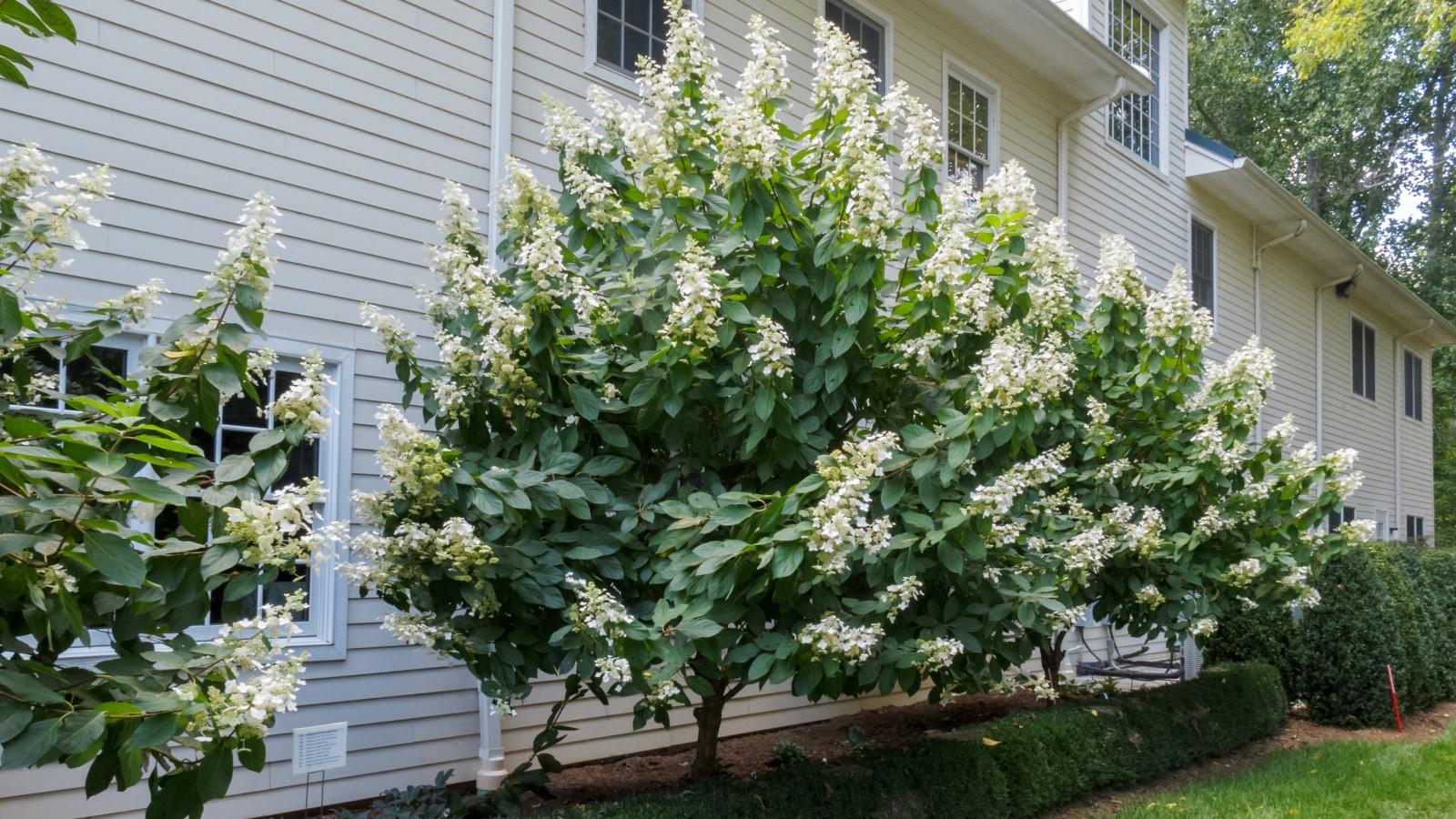Why prune hydrangeas?
Hydrangeas do not require extensive or regular pruning, and most pruning is done for aesthetic reasons to:
- Remove dead growth. Hydrangea varieties vary in their cold hardiness. Winter and spring weather conditions may cause stem damage, such as when mild temperatures are followed by drastic or rapid chilling, or when spring frosts occur after plants begin growth. Freezes may kill only flower buds or entire stems.
- Manage mature size. There are hundreds of hydrangea varieties with a range of mature sizes. Removing entire stems to force regrowth or shortening tall stems can change the shrub’s size for that season. Tall varieties of panicle hydrangeas are sometimes maintained as a “standard,” which uses pruning to give a shrub the appearance of a small tree.
- Rejuvenate old plants. Even healthy plants can experience occasional dieback of older stems. Pruning stimulates regrowth, which can freshen a plant’s appearance, and may also stimulate better flowering if the shrub is receiving enough light. In some cases, pruning might increase the size of flower clusters, even if the number of flower clusters is reduced overall.
- Reduce disease severity. Several leaf spot diseases can infect hydrangeas and cause unsightly symptoms by late summer. The risk of leaf infection is higher when plants are crowded or growth is very dense, such as growing close to neighboring plants or to a wall or solid fence. Reduced air circulation can slow the drying of leaves after rain, dew, or irrigation, creating vulnerability to infection.
- Remove spent flowers. Aging and faded hydrangea flowers can develop appealing colors and provide winter interest. Some gardeners prefer to remove them before they turn fully brown and dry. Trimming off faded flowers, called “dead-heading,” is not necessary for plant health, though it might encourage faster reblooming for hydrangea varieties capable of repeat flowering.

When to prune hydrangeas
Pruning timing depends on the type of Hydrangea you have. Hydrangea species fall into one of three categories based on how they develop their flower buds. Many hydrangeas cannot replace flower buds that were accidentally removed. If a loss of flowers is not a concern, then the timing of pruning is less critical, though still should be avoided close to winter dormancy.
The age of branch growth (wood) that produces the flower buds is the important trait:
-
Old wood is branch growth at least one year old. All of the branches present before hydrangeas break dormancy in spring is old wood. Hydrangeas blooming on old wood develop flower buds during summer and autumn the year prior to when those flowers open. The flower buds lie dormant on the stems during winter, and open the following spring or summer.
Prune just after the flowers fade. Bigleaf and mountain hydrangeas can be trimmed to about 12 inches off the ground. Oakleaf hydrangea can be pruned to the same height or left taller, especially for large-maturing varieties.
-
New wood is branch growth produced in the current growing season. Hydrangeas blooming on new wood develop flower buds just prior to opening them, either in spring or summer. Overwintering stems do not have any dormant flower buds on them because they have not yet formed.
Prune in late winter or early spring. Smooth hydrangea can be trimmed to about 12 inches off the ground. Panicle hydrangea can be pruned to the same height or left taller, especially for large-maturing varieties.
-
Remontant is the term used for shrubs capable of reblooming by producing flower buds on both old and new wood. The old wood buds open first, since they were already fully formed at the start of the season, followed by new wood flowers that keep forming well into the summer. Hydrangea varieties bred with this trait benefit gardeners whose shrubs frequently lose flower buds to cold damage, deer browsing, or mis-timed pruning.
Prune either in early spring or after the first flush of flowers has faded. Early-season pruning will delay the start of flowering, and mid-season pruning might interrupt or shorten the overall reblooming window, so the timing is a personal preference. Pruning height can vary but should remove as little wood as possible to avoid delaying new blooms.
Hydrangea flowering groups and pruning
| Old Wood: prune just after flowering | New Wood: prune in late winter |
|---|---|
| Oakleaf Hydrangea (Hydrangea quercifolia) |
Smooth Hydrangea (Hydrangea arborescens) |
| Bigleaf Hydrangea (Hydrangea macrophylla) |
Panicle Hydrangea (Hydrangea paniculata) |
| Mountain Hydrangea (Hydrangea serrata) |
Bigleaf Hydrangea* (Hydrangea macrophylla) |
| climbing hydrangeas** (Hydrangea anomala petiolaris) (Schizophragma hydrangeoides) |
Mountain Hydrangea* (Hydrangea serrata) |
* remontant varieties only
** climbing hydrangeas are not routinely pruned, but fall into this category
Identifying hydrangea species by bloom type
If you don't know what kind of hydrangea you are growing, compare the flowers to examples below. The only commonly-grown species that can produce blue or purple flowers are bigleaf hydrangea (Hydrangea macrophylla) and mountain hydrangea (Hydrangea serrata).


